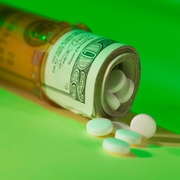GAO: Drug Couponing Affecting Medicare Reimbursement Rates
Federal auditors recommend the use of coupon program data to determine Medicare reimbursement rates for prescription drugs in order to reduce healthcare spending.

- The methodology for calculating Medicare reimbursement to providers for prescription drugs under the Part B program may be contributing to higher Medicare spending because it does not account for the impact of coupon programs, according to recent Government Accountability Office (GAO) report.

If CMS had determined the average sales price of prescription drugs based on the actual healthcare costs manufacturers received for the medication, it could have lowered Medicare spending by as much as $69 million in 2013, the study stated.
“As a result, coupon discounts create a discrepancy between Medicare’s ASP [average sales price] and the effective market price of a drug,” the GAO wrote. “This discrepancy, coupled with the recent increase in coupon use and Medicare’s role as an efficient purchaser of health care items and services, raises questions about how suitable Medicare’s Part B payment rate methodology is for drugs with coupon programs.”
Under the current methodology, Medicare determines provider payments for covered drugs based on the average amount that all purchasers — including providers and patients — paid to drug manufacturers net of all discounts and rebates, otherwise known as the average sales price.
However, many drug manufacturers offer privately-insured patients a coupon program that lowers out-of-pocket expenses and promotes medication adherence. Patients may receive a debit card to be activated when he purchases the drug or manufacturers may pay the provider, who could reduce the patient’s out-of-pocket expenses. The programs are designed to encourage patients and providers to select a company’s medication as the preferred treatment.
The federal government prohibits federal healthcare programs, such as Medicare, to use prescription drug coupon programs because it may be considered a kickback. Providers and beneficiaries may be induced to select certain medications based on the discount, even though a lower-cost alternative is available.
While Medicare does not allow coupon programs, it also does not calculate how the discounts impact the effective market price of prescription drugs when it determines provider payments. Manufacturers typically receive far less than the average sales price used by Medicare after coupon discounts have been received. For example, the average sales price reported by the manufacturer could be $1,000, but the effective market price could be closer to $700.
Manufacturers reported that coupon discounts for the 18 drugs in the GAO study totaled around $205 million in 2013.
As a result, GAO reported that Medicare’s average sales price was higher than the effective market value by an average of 0.7 percent for 18 prescription drugs. For five of the drugs in particular, the average sales price was anywhere between 1.4 to 7.8 percent higher, indicating Medicare spending could have been $50 million less for these five drugs combined in 2013.
The increasing use of coupon programs may also have a larger impact on the future of Medicare’s methodology for determining provider reimbursement rates for Part B drugs, GAO added. A cited study found that coupon programs more than doubled between 2011 and 2014. Some manufacturers in the study also told GAO that “the number of patients using coupon programs and the discount amounts that patients receive have increased over time.”
Out of the 50 costliest drugs in the Part B program, GAO found that 21 had a coupon program in 2013 and these medications represented half of Medicare Part B spending based on the average sales price.
The coupon programs are also widely used by privately insured patients, GAO reported. Out of the 18 manufacturers that GAO studied, all but two prescription drugs had around 40 percent or less participation in the coupon programs.
With prescription drug rates and out-of-pocket expenses on the rise for privately insured patients, GAO stated, coupon programs and their discounts are projected to increase. Medicare is at risk of even more wasteful spending as these programs gain traction.
GAO advised Congress to grant CMS the authority to gather coupon discount data from drug manufactures on Part B prescription drugs. The federal watchdog also recommended that Congress allow CMS to periodically collect coupon program data and report the impact that these programs may have on reimbursement methodology.
“These trends emphasize the need for regular monitoring of the implications that coupon programs may have for this methodology as CMS works to propose an alternative payment system,” the report concluded. “However, the agency lacks the authority to collect data on coupon discounts and therefore lacks important information that could inform its ongoing efforts to design and evaluate alternative approaches.”
Dig Deeper:
• Key Ways to Improve Claims Management and Reimbursement in the Healthcare Revenue Cycle
• How to Reduce Wasteful Spending in the Medicare Program
